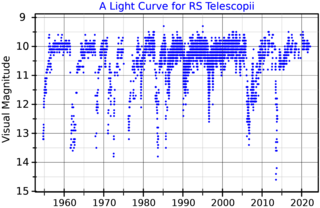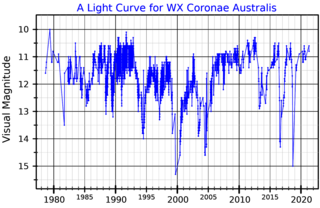
R Coronae Borealis is a low-mass yellow supergiant star in the constellation of Corona Borealis. It is the prototype of the R Cor Bor class of variable stars, which fade by several magnitudes at irregular intervals. R Coronae Borealis itself normally shines at approximately magnitude 6, just about visible to the naked eye, but at intervals of several months to many years fades to as faint as 15th magnitude. Over successive months it then gradually returns to its normal brightness, giving it the nickname "reverse nova", after the more common type of star which rapidly increases in brightness before fading.

T Coronae Borealis, is a recurring nova in the constellation Corona Borealis. It was first discovered in outburst in 1866 by John Birmingham, although it had been observed earlier as a 10th magnitude star.

UU Aurigae is a carbon star in the constellation Auriga. It is approximately 341 parsecs from Earth.
DY Persei variables are a subclass of R Coronae Borealis variables. They are carbon-rich asymptotic giant branch (AGB) stars that exhibit pulsational variability of AGB stars and irregular fades similar to R CrB stars.

An R Coronae Borealis variable is an eruptive variable star that varies in luminosity in two modes, one low amplitude pulsation, and one irregular, unpredictably-sudden fading by 1 to 9 magnitudes. The prototype star R Coronae Borealis was discovered by the English amateur astronomer Edward Pigott in 1795, who first observed the enigmatic fadings of the star. Only about 150 RCB stars are currently known in our Galaxy while up to 1000 were expected, making this class a very rare kind of star.

WZ Cassiopeiae is a deep red hued star in the northern constellation of Cassiopeia. It is a variable star with a magnitude that ranges from 6.3 down to 8.8, placing it near the limit of naked eye visibility at peak magnitude. The estimated distance to this star, as determined from its annual parallax shift of 2.1 mas, is about 1,540 light years. It is moving closer to the Earth with a heliocentric radial velocity of −34 km/s.

Theta Coronae Borealis, Latinized from θ Coronae Borealis, is a binary star system in the constellation Corona Borealis. It shines with a combined apparent visual magnitude of 4.13. There are two components: Theta Coronae Borealis A with an apparent magnitude of about 4.2, while Theta Coronae Borealis B lies around 1 arcsecond distant and has an apparent magnitude of 6.29. The system is located around 375 light-years from Earth, as estimated from its parallax of 8.69 milliarcseconds. It is estimated to be 85 million years old, with the primary star expected to remain on the main sequence burning its core hydrogen for another 75 million years and the secondary around 500 million years. Both stars will cool and expand once their core hydrogen is exhausted, becoming red giants.

Epsilon Coronae Borealis, Latinized from ε Coronae Borealis, is a multiple star system in the constellation Corona Borealis located around 230 light-years from the Solar System. It shines with a combined apparent magnitude of 4.13, meaning it is visible to the unaided eye in all night skies except those brightly lit in inner city locations. It is an orange giant around 1.7 times as massive as the Sun of spectral type K2III, which has exhausted its core fuel supply of hydrogen and swollen to 21 times the Sun's diameter and 151 times its luminosity. That is, Epsilon Coronae Borealis's diameter is about one-quarter of Mercury's orbit. Its surface temperature has been calculated to be 4365 ± 9 K, or 4406 ± 15 K. It is thought to be around 1.74 billion years old.

Delta Coronae Borealis, Latinized from δ Coronae Borealis, is a variable star in the constellation Corona Borealis. Its apparent magnitude varies regularly between apparent magnitude 4.57 and 4.69, and it is around 170 light-years distant.

Lambda Coronae Borealis, its name Latinised from λ Coronae Borealis, is a single star in the northern constellation of Corona Borealis. In publications it is also identified as HR 5936 and HD 142908. It has a yellow-white hue and is dimly visible to the naked eye with an apparent visual magnitude of 5.43. The star is located at a distance of 136 light years based on parallax, but is drifting closer with a radial velocity of −12 km/s.

RY Sagittarii is a yellow supergiant and an R Coronae Borealis type variable star in the constellation Sagittarius. Although it ostensibly has the spectrum of a G-type star, it differs markedly from most in that it has almost no hydrogen and much carbon.

9 Persei is a single variable star in the northern constellation Perseus, located around 4,300 light years away from the Sun. It has the Bayer designation i Persei; 9 Persei is the Flamsteed designation. This body is visible to the naked eye as a faint, white-hued star with an apparent visual magnitude of about 5.2. It is moving closer to the Sun with a heliocentric radial velocity of −15.2 km/s. The star is a member of the Perseus OB1 association of co-moving stars.

Z Ursae Minoris is a carbon star and R Coronae Borealis variable in the constellation Ursa Minor.

RS Telescopii, abbreviated RS Tel, is a variable star in the southern constellation of Telescopium. It is a dim star with an apparent visual magnitude of 10.67, which is much too faint to be visible without a telescope. The variability of this star was discovered by Evelyn F. Leland and announced by Edward C. Pickering in 1910. It was first studied by Cecilia H. Payne in 1928 at the Harvard College Observatory.

V Coronae Australis is a R Coronae Borealis variable (RCB) star in the constellation Corona Australis. These are extremely hydrogen-deficient supergiants thought to have arisen as the result of the merger of two white dwarfs; fewer than 100 have been discovered as of 2012. V Coronae Australis dimmed in brightness from 1994 to 1998.

WX Coronae Australis is an R Coronae Borealis star in the constellation Corona Australis, one of the brightest examples of this extremely rare class of variable star. Despite the rarity, Corona Australis hosts another R CrB star, V Coronae Australis.

Sigma Coronae Borealis is a star system in the constellation of Corona Borealis. It is a quintuple star system containing three sunlike main-sequence stars and two other low-mass stars. The combined visual magnitude is 5.3 and the system lies 74 light years from Earth. σ CrB A is the variable star TZ Coronae Borealis.

W Coronae Borealis is a Mira-type long period variable star in the constellation Corona Borealis. Its apparent magnitude varies between 7.8 and 14.3 over a period of 238 days.

Upsilon Coronae Borealis, Latinized from υ Coronae Borealis, is a solitary star in the northern constellation of Corona Borealis. It is a white-hued star that is dimly visible to the naked eye with an apparent visual magnitude of 5.78. The distance to this object is approximately 630 light-years based on parallax.

S Apodis, also known as HD 133444 is a variable star located in the southern circumpolar constellation Apus. It has an apparent magnitude ranging from 9.6 to 17, which is below the limit for naked eye visibility. The object is located relatively far at a distance of approximately 15,000 light years based on Gaia DR3 parallax measurements, but it is drifting closer with a heliocentric radial velocity of −75 km/s.




















